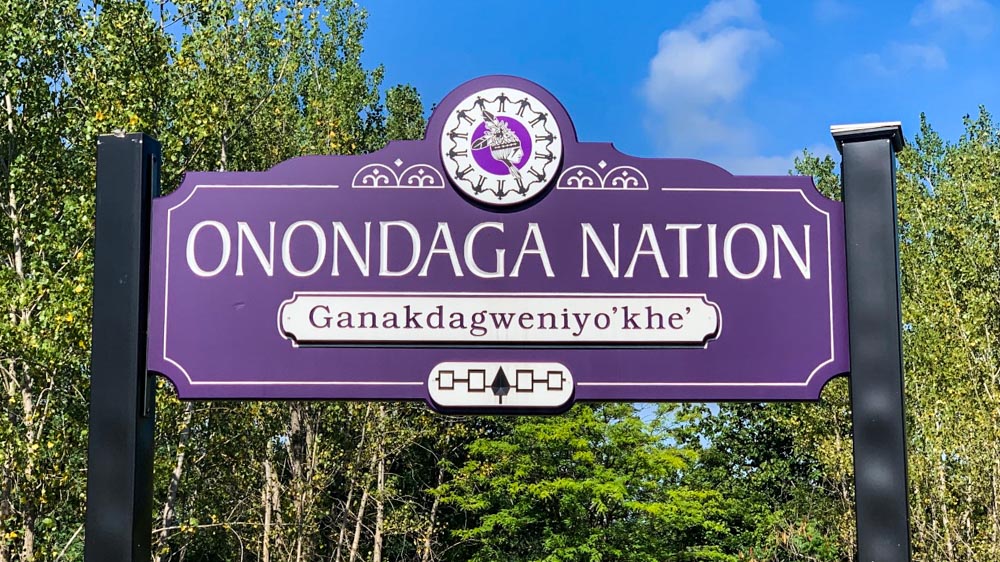
Nyaweñha sgé•noñ’
Welcome to the Onondaga Nation webpage. Nyaweñha sgé•noñ’ is our traditional greeting when we meet each other. It is roughly translated to- I am thankful that you are well.
The Onondaga Nation is a member of the Haudenosaunee Confederacy. The Haudenosaunee is translated to the People of the Longhouse which is an alliance of native nations united for hundreds of years by law, traditions, beliefs, and cultural values. The Haudenosaunee is also referred to as the Iroquois or the Six Nation Confederacy. The Haudenosaunee consist of the Mohawk, Oneida, Onondaga, Cayuga, Seneca, and Tuscarora nations.
The Onondaga Nation lies in the middle of the Haudenosaunee territory and is also known as the Central Fire. The Central Fire is a term used to describe Onondaga as a place where the Hoyá•neh (Chiefs) meet in a Grand Council. Because of this, the Onondaga Nation is also referred to as Ganakdagweñni•yo’geh, or the Capital.
Onondaga is still governed by our traditional government. Making Onondaga one of or the oldest continuous democratic government on Turtle Island. The tenants of the Great Law have kept the fourteen Onondaga Chiefs and their Clan Mothers caretakers of our land, ceremonies, and governmental relations with other nations. Because Onondaga has resisted all attempts by the United States to change Onondaga into a “tribal elective system”, the Onondaga Nation continues to maintain its sovereignty.
The Onondaga Nation is also referred to as the ‘Wampum Keepers’. For the Haudenosaunee, wampum is a very integral part of society. The purple and white shell beads have been woven into strings and belts for ceremonies, to carry messages, to record historical events, and to ratify treaties. Onondaga is home to ‘national’ belts such as the Hiawatha Belt, the Tadodaho Belt, the Dust Fan Belt, and the George Washington Belt. In 1890, New York State stole the belts from Onondaga. The Onondaga worked hard to have the belts returned and in 1989, the belts finally returned home. Since that time, the Onondaga use the belts as they were intended, during Grand Council meetings.
The Onondaga have lived here since time immemorial. The Onondaga Nation is located south of the City of Syracuse. Since the Onondaga have always lived here, the tern ‘reservation’ does not apply to us. Other native communities have been removed from their homeland to new a territory reserved for them by the United States. The responsibility of watching over the land at Onondaga falls to the women of the nation. Like our longhouses of long ago, they were the responsibility of a clan to take care of. The women of clan pass the clan and nationhood to their children.
Population on the nation consists of Onondagas, other Haudenosaunee citizens, and other native friends. The Onondaga Nation is not a part of the United States, does not receive funding from the United States, and has no elected official representing the Onondaga Nation. Therefore, the Onondaga Nation does not participate in the US census. Many Onondagas live throughout the other Haudenosaunee territories and around the world as well.
Schooling on the nation has had a checkered past. Children were separated from their parents to be ‘civilized’ at the Carlisle School of Indian Children in Pennsylvania or the Thomas Indian School in western New York. Then in 1850, the citizens of Syracuse petitioned New York State to begin a school for the children on the nation in the 1850s. Since that time, there has been a school on the Nation, the Onondaga Nation School. After the school house was destroyed by fire, in 1940, a brick building was erected and still stands today. In the 1970s, the Nation decided that the school did not serve the community. There was no Onondaga language or culture classes, only Spanish was offered at that time, and the school calendar did not align with our ceremonial cycle. Since that time, the school does offer language and culture classes and does work with our leaders to allow students to continue to learn in the longhouse.
The Onondaga Nation’s economy is based around its tax-free smoke shop. The shop allows the Nation to provide services and programs for the Nation such as Onondaga language instruction, a fire department, elder care, free drinking water, a lacrosse and athletics programs, a security force and much more. There is no gaming (such as bingo halls or casinos) on the Nation. The Council decided that such activities would be detrimental to our community and therefore decided not to create a gaming enterprise.
Dehoñtjihgwa’és or lacrosse is a very important aspect of life at Onondaga. Baby boys are given a stick at birth and men are buried with their stick when we pass on to the Creator’s World. We consider lacrosse to be a gift from our Creator. When played, the game so strong that its considered medicine and has the power to heal. Our team is called the RedHawks and we have teams aged 4 through adulthood. Our national team is called the Iroquois Nationals. The founding member of the Nationals is Oren Lyons, an Onondaga Faithkeeper, a Syracuse University All-American, and a former professor at the University of Buffalo.
There have been a few requests about how to refer about us. When discussing/writing about us, please use Onondaga, Onondaga Nation, Onondaga people, Haudenosaunee, or oñgwehoñwe’ (indigenous). Please refrain from using the term Indian (we are not from India) nor tribe/tribal (as this term was begun by the US to devalue our treaty/land rights).
The Onondaga Nation Council began the website in 2005. At that time, the Nation was suing the State of New York for violating US Federal law in taking Onondaga lands. We wanted to provide an avenue for people to find out more about the Onondaga and the site has grown. Nyaweñha (thank you) for taking the time to learn more about us.
Da•ne’tho’
(that is all)
